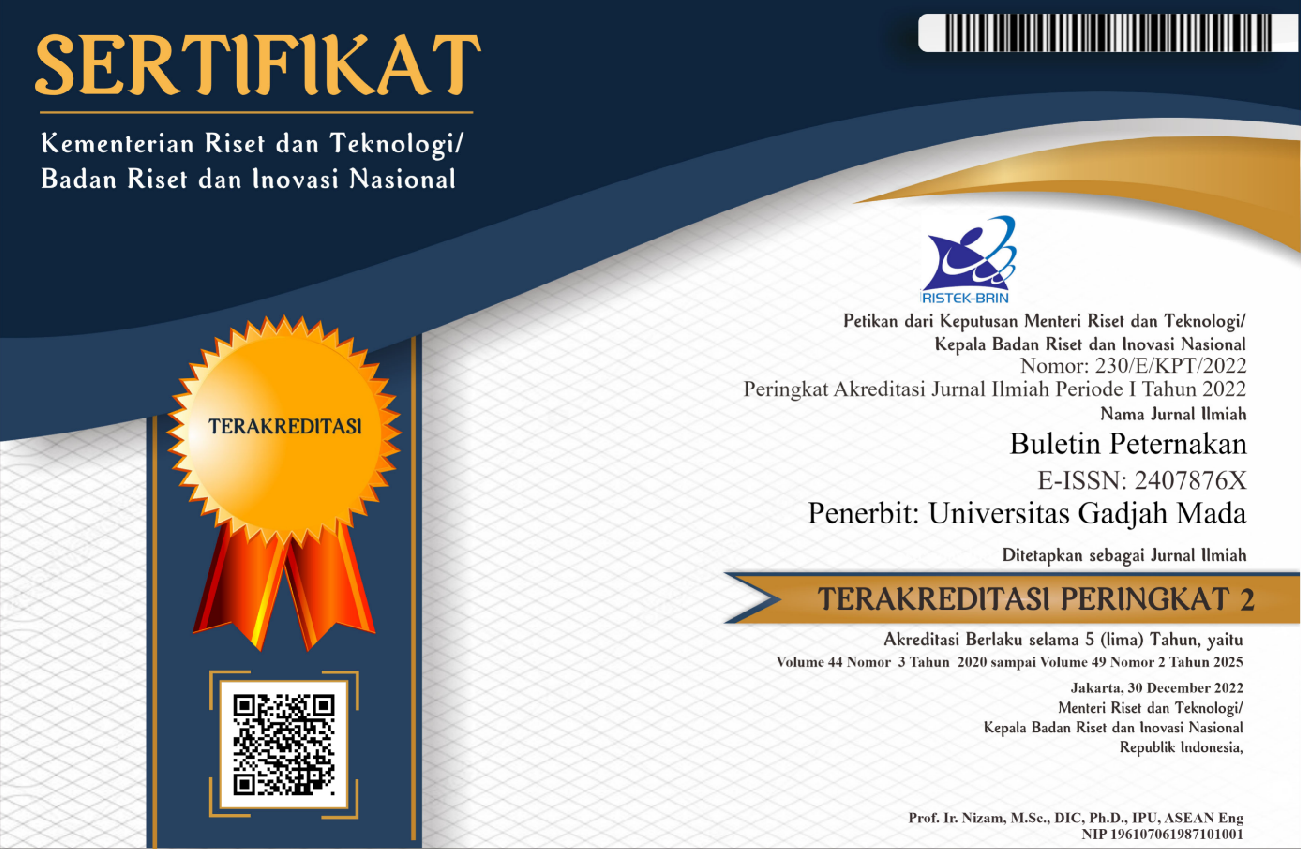Effects of L-Isoleucine Supplementation in the Diet on the Growth Performance of Kampong Chicken at the Starter Phase (1-6 Weeks)
Charles Venirius Lisnahan(1*), Lukas Pardosi(2), Oktovianus Rafael Nahak(3)
(1) Animal Husbandry Study Program, Faculty of Agriculture, Science and Health, University of Timor
(2) Animal Husbandry Study Program, Faculty of Agriculture, Science and Health, University of Timor
(3) Animal Husbandry Study Program, Faculty of Agriculture, Science and Health, University of Timor
(*) Corresponding Author
Abstract
This study aimed to determine the effect of L-isoleucine supplementation in the diet on the growth performance of Kampong chickens at the starter phase (1-6 weeks). This study was conducted at Kefamenanu, East Nusa Tenggara Province, Indonesia, from May to June 2023. A total of two hundred and fifty-week-old Kampong chickens with an average initial weight of 59.03±0.52 g were used in the study. The chickens were divided into five treatments with five replications based on a completely randomized design. The diet treatments were: T0 (control feed); T1 (T0 + 0.20% L-isoleucine, NRC, 1994 for broilers); T2 (T0 + 0.30% L-isoleucine); T3 (T0 + 0.40% L-isoleucine); and T4 (T0 + 0.50% L-isoleucine). The parameters observed were body weight, weight gain, feed intake, feed conversion ratio, carcass weight, and carcass percentage. The data obtained were analyzed using variance analysis and the Duncan test. The study result showed that the groups T3 and T2 had the highest body weight (330.76±1.29; 334.48±1.47 g/bird, respectively). The highest weight gain was in group T2 (275.54±1.39 g/bird/5 weeks). Group T3 had the highest feed intake (613.15±5.79 g/bird/5 weeks) and the lowest feed conversion ratio (2.22±0.02). The highest carcass weight was in groups T2 and T3 (189.95±1.17 and 189.32±0.65 g/bird, respectively), while the highest carcass percentage was in group T2 (57.43±0.47 %/bird). The statistical analysis indicated that body weight, weight gain, feed conversion ratio, and carcass weight were affected by the level of L-isoleucine (p<0.05). In contrast, feed intake and carcass percentage were not significant. It was concluded that supplementation with 0.40% L-isoleucine to the diet of Kampong chicken resulted in optimal growth performance at the starter phase (1-6 weeks).
Keywords
Full Text:
3. LisnahanReferences
Berres, J., S. L. Vieira, M. T. Kidd, D. Taschetto, D. M. Freitas, R. Barros, and E. T. Nogueira. 2010. Supplementing L-valine and L-isoleucine in low-protein corn and soybean meal all-vegetable diets for broilers. J. Appl. Poult. Res. 19: 373–379.
Corrent, E. and J. Bartelt. 2011. Valine and isoleucine: The next limiting amino acids in broiler diets. Lohmann Information 46: 69-67.
Corzo, A., E. T. Moran Jr. and D. Hohler. 2004. Isoleucine need of heavy broiler males. Arch. Geflugelk. 68: 194-198.
Duarte, K. F., O. M. Junqueira, R. S. Filardi, A. C. Laurentiz, C. H. F. Domingues, and E. A. Rodrigues. 2015. Digestible isoleucine requirements for 22- and 42-day-old broilers. Acta Sci. Anim. Sci. 37: 23-28.
Erwan, E., A. R. Alimon, A. Q. Sazili, and H. Yaakub. 2008. Effect of varying levels of leucine and energy on performance and carcass characteristics of broiler chickens. Int. J. Poult. Sci. 7: 696-699.
Holecek, M. 2018. Branched-chain amino acids in health and disease: metabolism, alterations in blood plasma, and as supplements. Nutr. Metab. 15: 1-12.
Holecek, M. 2022. Side of amino Acid supplements. A review. Physiol. Res. 71: 29-45.
Kidd, M. T., C. W. Maynard, and G. J. Mullenix. 2021. Progress of amino acid nutrition for diet protein reduction in poultry. J. Anim. Sci. Biotechnol. 12: 1–9.
Lima, M. B., N. K. Sakomura, E. P. Silva, J. C. P. Dorigam, N. T. Ferreira, and J. B. K. Fernandes. 2018a. Maintenance valine, isoleucine, and tryptophan requirements for poultry. Poult. Sci. 95: 842–850.
Lima, M. B., N. K. Sakomura, E. P. Silva, J. C. P. Dorigam, N. T. Ferreira, E. B. Malheiros, and J. B. K. Fernandes. 2018b. The optimal digestible valine, isoleucine and tryptophan intakes of broiler breeder hens for rate of lay. Anim. Feed Sci. Technol. 238: 29–38.
Lisnahan, C. V., Wihandoyo, Zuprizal, and S. Harimurti. 2017. Growth performance of native Chickens in the grower phase fed methionine and lysine-supplemented cafeteria standard feed. Pak. J. Nutr. 16: 940-944.
Lisnahan, C. V., O. R. Nahak, and L. Pardosi. 2022. Effect of L-arginine and L-Lysine HCl ratio on growth performance and ileum morphology of native chickens aged 2-14 weeks. Vet. World. 15: 1365-1372.
NRC. 1994. Nutrient Requirements of Poultry. 8th ed. National Academy Press, Washington DC. 155 p.
Ospina-Rojas, I. C., A. E. Murakami, C. R. A. Duarte, G. R. Nascimento, E. R. M. Garcia, M. I. Sakamoto, and R. V. Nunes. 2017. Leucine and valine supplementation of low-protein diets for broiler chickens from 21 to 42 days of age. Poult. Sci. 96: 914–922.
Ospina-Rojas, I. C., P. C. Pozza, R. J. B. Rodrigueriro, E. Gasparino, A. S. Khatlab, and A. E. Murakami. 2020. High leucine levels affecting valine and isoleucine recommendations in low-protein diets for broiler chickens. Poult. Sci. 99: 5946-5959.
Rocha, T. C., J. L. Donsele, P. C. Gomes, H. H. C. Mello, A. R. Troni, and G. S. Viana. 2013. Ideal digestible isoleucine: digestible lysine ratio in diets for laying hens aged 24-40 weeks. Rev. Bras. Zootec. 42: 780-784.
Samadi. 2012. Konsep ideal protein (asam amino) fokus pada ternak ayam pedaging. Ideal protein (amino acids) concept focused on broiler. Jurnal Agripet 12: 42–48.
Steel, R. G. D. and J. H. Torrie. 1995. Principles and Procedures of Statistics: A Biometrical Approach. 2nd ed. McGraw-Hill Book Company, New York.
Tavernari, F. C., G. R. Lelis, P. R. O. Carneiro, R. A. Vieira, R. C. Polveiro, J. A. P. Luengas, H. S. Rostagno, and L. F. T. Albino. 2012. Effect of different digestible isoleucine/lysine rations for broiler chickens. R. Bras. Zootec. 41: 1699–1705.
Article Metrics
Refbacks
- There are currently no refbacks.

This work is licensed under a Creative Commons Attribution-ShareAlike 4.0 International License.
Buletin Peternakan (Bulletin of Animal Science) Indexed by:

This work is licensed under a Creative Commons Attribution-ShareAlike 4.0 International License.










